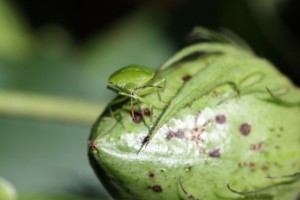The bollworm flight has begun in many areas. A general decline in plant bug populations is being observed, but stink bugs continue to linger. Some fields of cotton have now reached a maturity where we should and have terminated insecticide applications for plant bugs, stink bugs and bollworms. For later maturing fields, it may still be necessary to manage pest infestations for a couple of more weeks.
Keep in mind that the last effective bloom date in upon us (August 10-15). This is the average date that a white flower has a 50% chance of making a harvestable boll. It is a crap shoot whether bolls set after this date have time to mature before a frost. For late maturing fields that are just now or have not reached NAWF5, it is still advisable to continue to good insect management practices for 2-3 weeks to allow these last bolls to accumulate enough heat units (350 DD60s) to be relatively safe from insect attack.
With that is mind, it is also advisable to “relax” our treatment threshold once we pass the last effective boll date for a couple of several reason.
- The last effective bloom date mentioned above represent a 50% chance that a new boll will make it into the picker. Thus, there is a pretty good chance these bolls will not contribute to yield.
- The upper, less mature bolls typically are smaller in size and number and represent a relatively small proportion of the overall yield. Of course, this assumes average or better boll retention on the bottom two-thirds of the plants.
 My suggestion from this point forward is to pay more attention to stink bug and bollworm infestations than to plant bugs. Stink bugs and bollworms are more likely to injure bolls. Spending a lot of money to protect squares and small bolls from plant bugs at this late date is a questionable decision. Of course, we have some built in protection from bollworm because almost everything is Bt Cotton. However, WideStrike cotton in particular does not always provide adequate protection against moderate to heavy infestations, and insecticide applications may be justified. This includes Phytogen 333 WRF and Phytogen 499 WRF. Bollgard II varieties are not immune to bollworm or fall armyworm infestations. This is one reason I seldom make a insecticide recommendation at this time of year that does not include a pyrethroid. Pyrethroid insecticide give us some insurance against late stink bug and bollworm infestations.
My suggestion from this point forward is to pay more attention to stink bug and bollworm infestations than to plant bugs. Stink bugs and bollworms are more likely to injure bolls. Spending a lot of money to protect squares and small bolls from plant bugs at this late date is a questionable decision. Of course, we have some built in protection from bollworm because almost everything is Bt Cotton. However, WideStrike cotton in particular does not always provide adequate protection against moderate to heavy infestations, and insecticide applications may be justified. This includes Phytogen 333 WRF and Phytogen 499 WRF. Bollgard II varieties are not immune to bollworm or fall armyworm infestations. This is one reason I seldom make a insecticide recommendation at this time of year that does not include a pyrethroid. Pyrethroid insecticide give us some insurance against late stink bug and bollworm infestations.

